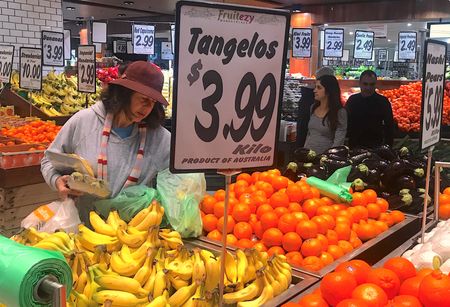By Stella Qiu
SYDNEY (Reuters) – Australian consumer prices rose by more than expected in April on a jump in fuel prices and strong gains in housing, suggesting sticky inflation will likely keep pressure on the central bank.
The consumer price index (CPI) rose 6.8% in April from a year earlier, Australian Bureau of Statistics data showed on Wednesday, compared with 6.3% in March and market forecasts of 6.4%.
On a monthly basis, CPI rose by a strong 0.8% from March. Prices excluding volatile fruit, vegetables and fuel and holiday travel, rose 6.5% in the year to April, down from 6.9% in March.
The Australian dollar hit a session high of $0.6538 after the data but soon unwounded gains on soft China data. Markets have nudged up the chances of a quarter-point hike next month to 28%, seeing terminal rates reach 4.1% by September, compared with 4.0% before.
“It now looks more likely than not that Q2 inflation will overshoot the RBAs forecast of 6.3%,” said Marcel Thieliant, a senior economist at Capital Economics.
“Coupled with the increasing strength of the rebound in the housing market and continued sluggish productivity growth, that will almost certainly convince the RBA to raise interest rates again, perhaps as soon as next week.”
The Reserve Bank of Australia has warned that more rate rises may be required to bring inflation back to target by mid-2025, having raised interest rates by 375 basis points since May last year to an 11-year high of 3.85%.
Economic data over the past month has largely been on the soft side. Retail sales were flat in April as consumers cut back spending on food and dining out, quarterly gains in wages missed forecasts and a red-hot labour market showed signs of cooling.
Wednesday’s data showed the most significant drivers were an 8.9% jump in housing, a 7.9% increase in food and non-alcoholic beverages and a 7.1% rise in transport costs.
(Reporting by Stella Qiu; Editing by Sam Holmes and Jacqueline Wong)





